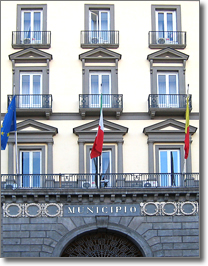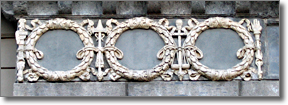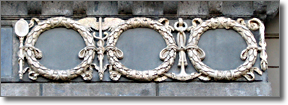
The institutional role covered by the San Giacomo building needed to be clear to anyone who might stop to look at its imposing facade. The importance, however, of celebrating the reigning dynasty must not be underestimated.
The problem of communicating this kind of dual public and political message was solved by using the symbolic language inherent in the architectural style which was fashionable at the time. On the plaque it said "Ministers of State" but there was a frieze on each side of the writing depicting lots of ancient symbols.
The language would probably not be understood by everyone but, for the period, it was undoubtedly a reference to the symbolic language mainly used in Western Classicism. Each of the symbols was supposed to remind people of the original meaning attached to them, so that anyone who knew how to interpret the code would be able to understand the message.
The friezes are still there. The inscription that separated them has changed and even the friezes were modified slightly after the fall of the Kingdom of the Two Sicilies. However, the message conveyed by them can still be worked out.
Each of the two ornamental friezes consisted of three wreaths and four objects. The wreaths surrounded a Bourbon lily, the symbol of the family on the throne at the time (in 1860 there was a saying about removing dynasty symbols which went: "down with lilies") while the objects were an allusion to the powers of the sovereign and the roles of the different departments working in the Building. (From the 1800s until the end of the 1950s there were eight Royal Secretaries and Ministers of State, namely the Prime Minister, Minister for Foreign Affairs, for Grace and Justice, for Ecclesiastical Affaire, for War and the Navy, for the General Police).
There are three wreaths on each frieze (just as there are three lilies on the shield in the centre of the Bourbon-Two Sicilies' coat of arms). Two of them are laurel branches with berries while the one in the centre is an oak branch with acorns. The wreaths which encircle the royal lily are an emblematic celebration of the dynasty and the message is only too clear if we interpret the symbolic meaning attached to the kind of tree used. Laurel was sacred to Apollo and represented everything heroic, and immortality acquired through victory. The oak, on the other hand, was sacred to Zeus and represented strength, solidity, power and a long life.
In both friezes, the four objects alternate with the wreaths and are tied to them. It is clear, therefore, that the concepts represented by these symbolic objects were closely linked to the power of the sovereign.


